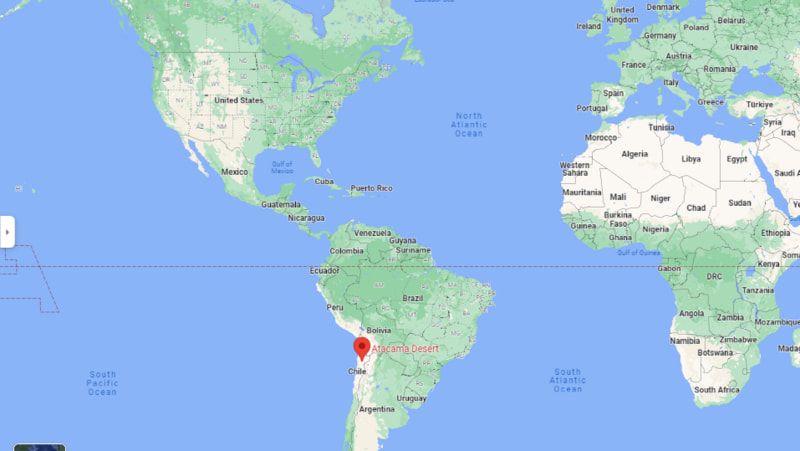The Atacama Desert is located in South America, on the western coast of Chile. It is a plateau desert, stretching over 1,600 kilometers (990 mi) along the Andes Mountains. It covers an area of 105,000 km2 (41,000 sq mi). The Atacama Desert is the driest non-polar desert in the world. Some areas of the desert have never received any rainfall. The average annual rainfall in the Atacama Desert is less than 1 millimeter (0.04 inches).
Location Map of Atacama Desert, Chile
 About Map: Map showing Where is Atacama Desert, Chile located in the Map.
About Map: Map showing Where is Atacama Desert, Chile located in the Map.
About Atacama Desert
The Atacama Desert is a vast arid region located in South America, primarily in northern Chile. Here is some information about the Atacama Desert.Location: The Atacama Desert stretches along the Pacific coast of South America, covering parts of northern Chile, southwestern Bolivia, and a small portion of southern Peru. It is bordered by the Pacific Ocean to the west and the Andes Mountains to the east. Size: The Atacama Desert is one of the driest places on Earth and is considered the driest non-polar desert in the world. It covers an area of approximately 105,000 square kilometers (41,000 square miles).
Extreme Aridity: The Atacama Desert is known for its extreme aridity. The region receives very little rainfall, and some areas in the desert have reported no rainfall for years. It is this lack of moisture that contributes to its otherworldly landscapes and unique ecosystems. Geological Features: The Atacama Desert is characterized by a diverse range of geological formations. It is home to vast salt flats, such as the Salar de Atacama, sand dunes, volcanic peaks, geysers, hot springs, and expansive desert plains. The desert's terrain is often compared to a lunar or Martian landscape. Biodiversity: Despite its harsh conditions, the Atacama Desert supports a surprising array of plant and animal life. It is known for its unique and endemic species, including cacti, succulents, and hardy desert-adapted animals such as vicuñas, flamingos, and the Andean fox. In certain parts of the desert, microbial life has been discovered, showing the resilience of life in extreme environments.
Astronomical Observatories: The Atacama Desert is an ideal location for astronomical observations due to its high altitude, clear skies, and minimal light pollution. The region is home to several world-class observatories, including the Paranal Observatory and the Atacama Large Millimeter/submillimeter Array (ALMA), which allow astronomers to study the universe with exceptional clarity. Tourism: The Atacama Desert has become a popular tourist destination, attracting visitors who are captivated by its surreal landscapes, stargazing opportunities, and unique flora and fauna. Tourists can explore the desert's natural wonders, visit geothermal areas, witness spectacular sunsets, and even take part in adventure activities such as sandboarding or trekking. The Atacama Desert is a captivating and otherworldly desert landscape known for its extreme aridity, breathtaking geological formations, and remarkable biodiversity. Its uniqueness and natural beauty make it a remarkable destination for nature enthusiasts, adventurers, and those seeking to witness the wonders of an arid desert environment.
World Travel Destinations
- 100 Wonders Of The World
- 7 Wonders Of World
- Where is Acropolis
- Where is Alhambra
- Where is Amalfi Coast
- Where is Amazon Rainforest
- Where is Angel Falls
- Where is Angkor Wat
- Where is Bali
- Where is Banaue Terraces
- Where is Bora Bora
- Where is Borobudur
- Where is Burj Khalifa
- Where is Cappadocia
- Where is Carlsbad Caverns
- Where is Chichen Itza
- Where is Colosseum Of Rome
- Where is Dubrovnik
- Where is Easter Island
- Where is Eiffel Tower
- Where is Fjords Of Norway
- Where is Galapagos Islands
- Where is Grand Canyon
- Where is Great Barrier Reef
- Where is Great Pyramid Of Giza
- Where is Great Wall Of China
- Where is Iguazu Falls
- Where is Konark Temple
- Where is Leaning Tower Pisa
- Where is Louvre Museum
- Where is Machu Picchu
- Where is Marrakesh
- Where is Matterhorn
- Where is Mecca
- Where is Mount Everest
- Where is Pagan Temples
- Where is Petra
- Where is Pompeii
- Where is Portofino
- Where is Potala Palace
- Where is Sahara Desert
- Where is Santorini
- Where is Sistine Chapel
- Where is Stonehenge
- Where is Suez Canel
- Where is Taj Mahal
- Where is Teotihuacan
- Where is Terracotta Warriors
- Where is Valley Of The Kings
- Where is Versailles
- Where is Victoria Falls
- Where is Mount Rushmore
- Where is Prague
- Where is Tunis
- Where is Curacao
- Where is Babylon
- Where is Death Valley
- Where is Tahiti
- Where is Oak Island
- Where is Mount Fuji
- Where is Timbuktu
- Where is Canary Islands
- Where is Monte Carlo
- Where is Atlantis
- Where is Dead Sea
- Where is Amalfi Coast
- Where is Kosovo
- Where is Great Barrier Reef
- Where is Panama Canal
- Where is The Red Sea
- Where is Aconcagua Mountain
- Where is Azores
- Where is Devil'S Tower
- Where is Antwerp
- Where is The Faroe Islands
- Where is Santorini
- Where is Kilimanjaro
- Where is Banff National Park
- Where is Mount Olympus
- Where is Ninevah
- Where is Mount Etna
- Where is Deadwood
- Where is Lake Titicaca
- Where is Yucatan Peninsula
- Where is Mount Mckinley
- Where is Angel Falls
- Where is The Blue Lagoon
- Where is Petrified Forest
- Where is Rock Of Gibraltar
- Where is Glass Beach
- Where is Atacama Desert
- Where is Mount Ararat
- Where is Falkland Islands
- Where is Channel Islands
- Where is Badlands National Park
- Where is Tree Of Life
- Where is Dubrovnik
- Where is Loch Ness
